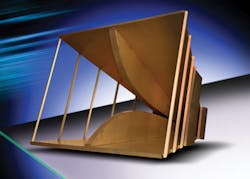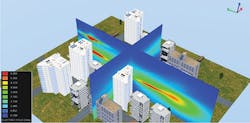This sampling of products for implementing and testing compliance with EMC requirements ranges from software tools to high-frequency, high-power amplifiers. Software tools include Modelithics’ models for Coilcraft inductors as well as MVG’s EMF Visual software, which can help designers keep up with telecommunication regulatory bodies worldwide that are paying more attention to human exposure to RF emissions. Hardware products extend from micro metal parts to a 20,000-W forced-air-cooled, broadband solid-state microwave amplifier.
Conical inductors
BCL/BCR Series conical inductors are suitable for ultrawideband bias tees, provide flat bandwidth with high impedance to 40 GHz, and can replace a series of narrowband inductors. The BCL Series comes with flying leads, which allow precise positioning and adjustment of the mounting angle. The BCR Series surface-mount inductors feature a protective cap that provides a large surface for pick-and-place handling. A self-positioning mounting bracket has four soldered pads for enhanced board adhesion. Coilcraft
Two Microwave Global Models for the BCL and BCR RF and microwave inductor families are high-accuracy equivalent circuit models that cover the entire component series. These models feature substrate, pad, and part-value scalability (or selectability) and accurately predict parasitic effects based on the model parameter settings. These features allow designers to simulate condition-specific response of their designs electronically and perform advanced analysis of their designs with efficiency and accuracy.
The BCL (flying-lead) and BCR (surface-mount) Series inductor models each come in two versions for series and shunt configurations. Each model is measurement-validated to 50 GHz and includes all available part values in the series. The models also are substrate-scalable over a range of material thickness and dielectric constant properties, an important feature in high-frequency design. Modelithics
Primarily intended for EMC test applications, the AM0.2-2HA open-sided, linearly polarized horn antenna operates over the 200-MHz to 2-GHz frequency range. It can be used as either a transmitter or a receiver for measurements of products’ immunity or emissions in accordance with international EMC standards laid down by organizations such as IEC, ISO, and CISPR. The antenna handles up to 200 W of microwave power and features a low average VSWR of 1.6:1, a field-strength capability of 250 V/m at 1 m, and a nominal impedance of 50 Ω. It also offers gain uniformity, with gain only varying from 5 to 9 dBi over the entire operating frequency range.
The horn antenna is equipped with a precision N-type female connector and a mounting bracket that enable the user to switch between vertical and horizontal polarizations. A standard camera thread allows easy mounting on a wide variety of tripods. The AM0.2-2HA antenna is fabricated from aluminum to provide a rugged, corrosion-resistant construction. It measures 980 x 980 x 730 mm and weighs 12 kg. Link Microtek
Human exposure simulation
In addition, the new version allows users to assign material properties to the entire surrounding 3D environment to take into account their impact on exposure levels and still make fast calculations. Microwave Vision Group
State-of-the-art techniques enable the forming of features down to 0.003 inch in a wide variety of metals. The vendor can provide engineers the freedom to design features in thin metal parts with few limitations. Parts range in thickness from 0.0005 inch and up. While providing quick turnaround and low tooling costs, the vendor’s photo-etching process produces burr-free parts with intricate and complex shapes. Prototypes can be delivered in five days. Laminating, plating, heat treating, and assembly are available in-house. The vendor is ISO 9001:2008 registered and manufactures precision metal parts and related EMI/RFI shielding products. Tech-Etch
Broadband amplifier
The Model 20000SP1G2 is a self-contained, forced-air-cooled, 1- to 2-GHz broadband solid-state microwave amplifier designed for pulse applications at low duty factors where instantaneous bandwidth and high gain are required. The unit provides a conservative 20,000-W minimum peak RF pulse power at the amplifier output connector. Stated power specifications are at the fundamental frequency.
The amplifier is equipped with a digital control panel, which allows both local and remote control of the amplifier. The DCP uses a color LCD touchscreen and a single rotary knob to offer status reporting and control capability. The display provides forward power and reflected power values plus amplifier status. Special features include a gain control and RF output level protection. AR RF/Microwave Instrumentation
The latest update to XFdtd 3D electromagnetic simulation software includes a new capability to import flexible PCB designs. XFdtd’s PCB import dialog now features the option to wrap a design, such as a flexible circuit, onto a form automatically during the import process. The wrap option conforms the PCB and all of its parts onto the flexible-circuit geometry, eliminating the need to bend the model into the desired shape or manually wrap each layer.
Another addition in the new release is dielectric volume averaging, which increases simulation accuracy for simulations with high-permittivity materials, such as ceramic chip antennas. The company said the new update has the potential to transform the device design workflow for engineers in a variety of industries, including mobile devices, exercise monitors, and automotive instrument panels. Remcom
The Smart DC/DC ENA200-Charger is designed to meet new market requirements for intelligent and flexible charging solutions for demanding automotive and industrial applications. It includes a microcontroller with firmware to guarantee optimum charging and longer battery lifetime with predefined charging algorithms for standard lead acid, absorbed glass matte (AGM), gel cell, and calcium batteries. Application-defined profiles can be uploaded at the vendor’s configuration center to meet a customer’s specific application.
The ENA200-Charger handles load temperature monitoring and intelligent spark control. It is available in two input voltages for 12-V and 24-V systems. The unit provides galvanic isolation of 500 VDC (input/output/case). Designed to meet immunity standard ISO7637-2, the ENA200-Charger sustains 2-kV surge and applicable parts of the EMC EN 61000. The ENA200-Charger is RoHS II- and REACH-compliant. Powerbox
The SMF3.3 Series TVS diode combines 200-W surge capability, low reverse standoff voltage (3.3 V), and low clamping voltage (6.8 V) with a small-footprint, low-profile SOD-123FL plastic package for a variety of portable and compact electronic products. The SMF3.3 Series is suitable for low-voltage applications such as the protection of VCC buses and other vulnerable circuits used in portable devices, portable hard drives, notebooks, POS terminals, solid-state drives, power supplies, and monitors.
SMF3.3 Series TVS diodes offer a 200-W surge capability; their small and flat-lead low-profile (1.08-mm) SOD-123FL plastic package optimizes the use of circuit board space, making it a good choice for portable devices and consumer applications. They also promote high ESD immunity, permitting manufacturers to achieve ESD protection beyond the maximum level stated in the IEC standard and to protect against a multitude of other threats to ensure product reliability in the field. Littelfuse
The R&S ESW EMI test receiver is designed for applications in EMI labs and test houses. It can carry out fast prequalification tests—in particular certification tests—on modules, components, devices, systems, and technical facilities in line with all relevant commercial and military standards.
The instrument’s ultrafast FFT-based time-domain scan delivers standard-compliant measurements; these measurements can even be run with two CISPR detectors in parallel. The R&S ESW offers a wide dynamic range and level accuracy. It can be used for EMI measurements starting from 2 Hz, such as those required in the aerospace-and-defense and automotive sectors. Rohde & Schwarz
About the Author

Rick Nelson
Contributing Editor
Rick is currently Contributing Technical Editor. He was Executive Editor for EE in 2011-2018. Previously he served on several publications, including EDN and Vision Systems Design, and has received awards for signed editorials from the American Society of Business Publication Editors. He began as a design engineer at General Electric and Litton Industries and earned a BSEE degree from Penn State.








